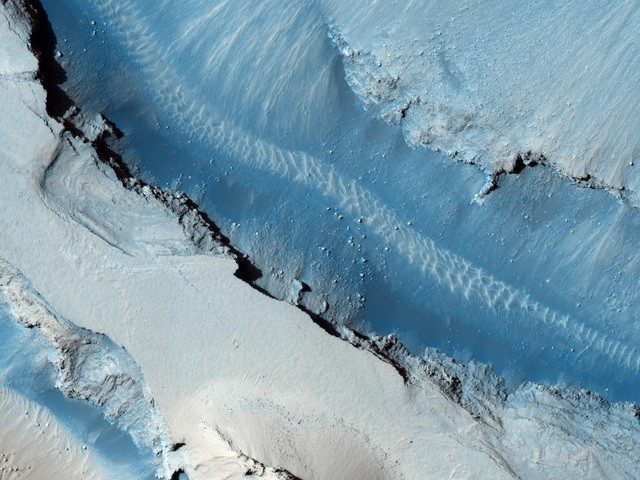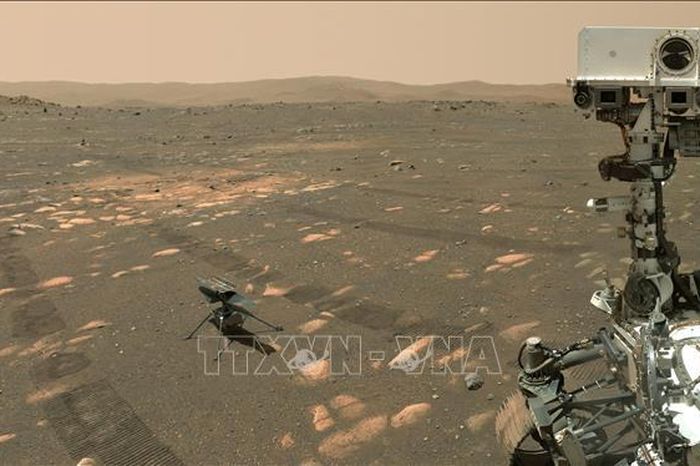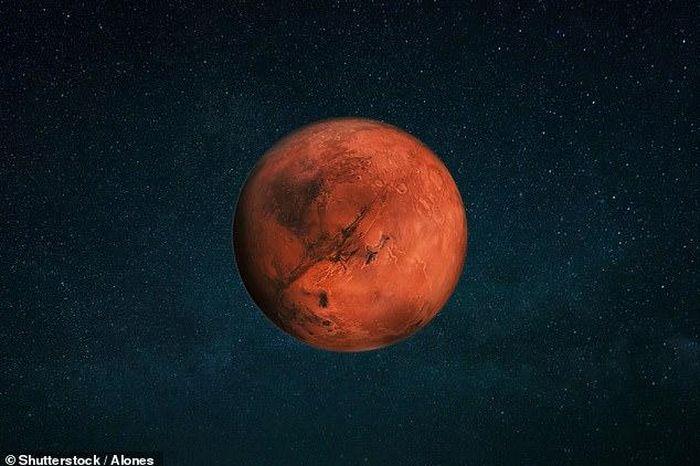Space collision sends NASA lost on another planet
In an effort to learn about Mars - a planet that is being carefully "cared for" by many NASA spacecraft - scientists have identified 123 new impact craters that were formed between December 2018 and December 2022.
49 of them may have led scientists astray when analyzing data from the InSight lander.

The magical landscape of the Cerberus Fossae area - Photo: NASA
NASA's InSight lander is a stationary craft used to measure seismic activity on the red planet. After its last communication on December 25, 2022, InSight "died" due to Martian dust burying its solar panels.
Yet in more than two years of operation, InSight has detected more than 1,300 earthquakes on our neighboring planet.
These data have provided the foundation for many groundbreaking studies of Mars, including understanding the planet's internal structure, as well as a better understanding of how all rocky worlds, including Earth and the Moon, formed.
But two studies recently published in the scientific journal Geophysical Research Letters, led by NASA, show that the interior of the red planet still contains unexplained things.
Most prominent is data from a 21.5-meter-diameter impact crater in Cerberus Fossae, a particularly quake-prone region on Mars, 1,640 kilometers from InSight.
The crater is much farther away than InSight expected based on the seismic energy of the quake.
Mars' crust has unique properties that are thought to dampen seismic waves generated by impacts. New analysis of the Cerberus Fossae impact suggests the waves it generated took a more direct path through the planet's mantle.
Dr Constantinos Charalambous from Imperial College London (UK), a member of NASA's InSight team, said they had thought that the energy detected from most seismic events was trapped in the Martian crust.
But new analysis of the impact crater at Cerberus Fossae reveals a deeper, faster path they call a 'seismic highway' through the mantle, allowing seismic waves to travel farther across the planet.
Researchers also searched for impact craters within a radius of about 3,000 kilometers from InSight's location, hoping to find some that formed during the rover's operations.
By comparing images from the Context Camera on NASA's Mars Reconnaissance Orbiter (MRO), they found 123 new craters, 49 of which likely matched quakes detected by the lander's seismometer.
"We thought Cerberus Fossae produced a lot of high-frequency seismic signals associated with internal earthquakes, but this suggests that some of the activity is not originating there and may actually be coming from impacts," said Dr Charalambous.
While this has forced scientists to revise some models regarding the internal structure of Mars, it has also opened new doors in the study of the geology of rocky planets.
You should read it
- Why are microorganisms living 'so tough' on Earth but still hard to survive on Mars
- NASA found traces of methane gas near a crater on Mars
- NASA 'headache' trying to find a way to bring samples from Mars back to Earth
- 5 most interesting findings about Red Planet
- Looking back at NASA's Mars exploration process over the past 20 years
- NASA 'Mars' helicopter model is almost ready for the journey to conquer Red Planet
- Three potential landing locations are listed in the Martian Mission in 2020
- The Ingenuity exploration helicopter on Mars sends final information back to Earth
May be interested
- More than 1,000 new asteroids discovered thanks to 'photobomb' phenomenon
 the hubble space telescope is famous for its clear, eye-catching images of distant galaxies, and is also useful in helping to study objects within our own solar system.
the hubble space telescope is famous for its clear, eye-catching images of distant galaxies, and is also useful in helping to study objects within our own solar system. - Warning signs you may be lactose intolerant
 lactose intolerance occurs in people who lack the enzyme needed to break down lactose, the sugar in milk. here are common signs of lactose intolerance.
lactose intolerance occurs in people who lack the enzyme needed to break down lactose, the sugar in milk. here are common signs of lactose intolerance. - Interesting facts about dinosaurs you may not know
 dinosaurs have become some of the strangest animals to ever exist on this planet. here are some of the most amazing facts about dinosaurs you can imagine.
dinosaurs have become some of the strangest animals to ever exist on this planet. here are some of the most amazing facts about dinosaurs you can imagine. - Interesting facts about bread you may not know
 bread is not only one of many people's favorite foods, it has also been a part of human culture and symbolism since long before recorded history.
bread is not only one of many people's favorite foods, it has also been a part of human culture and symbolism since long before recorded history. - Side Effects of Too Much Caffeine
 although caffeine is generally safe in low to moderate amounts, consuming large amounts can lead to unpleasant and even dangerous side effects.
although caffeine is generally safe in low to moderate amounts, consuming large amounts can lead to unpleasant and even dangerous side effects. - Why Mosquitoes Are Always Buzzing Around Our Ears and Simple Ways to Fix It
 how to stop mosquitoes from buzzing around your ears is simpler than many people think. if you find mosquitoes buzzing around your ears, read the article below to find out why.
how to stop mosquitoes from buzzing around your ears is simpler than many people think. if you find mosquitoes buzzing around your ears, read the article below to find out why.






 Police protect the planet: Light pay high, stable to doomsday, receive 200,000 USD / year from NASA
Police protect the planet: Light pay high, stable to doomsday, receive 200,000 USD / year from NASA The Ingenuity exploration helicopter on Mars sends final information back to Earth
The Ingenuity exploration helicopter on Mars sends final information back to Earth NASA found traces of methane gas near a crater on Mars
NASA found traces of methane gas near a crater on Mars Admire the design of the most award winning NASA space design competition: Harmony, full of comfort, and safety
Admire the design of the most award winning NASA space design competition: Harmony, full of comfort, and safety Discovering the planet has an orbit of 4.5 hours, where people can live 150,000 years
Discovering the planet has an orbit of 4.5 hours, where people can live 150,000 years